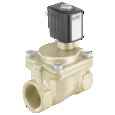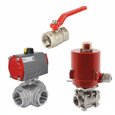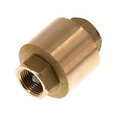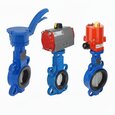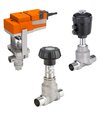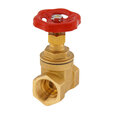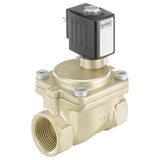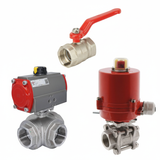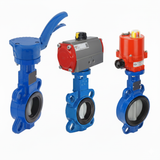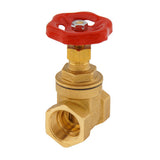HVAC Water Based Heat Transfer
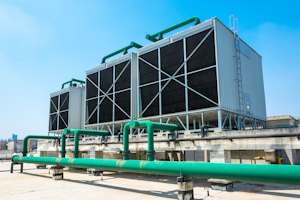
Figure 1: Cooling towers are common heat transfer HVAC units that use water to cool down industrial processes.
Water-based heat transfer systems are integral to the functionality of HVAC systems, providing efficient and reliable temperature regulation within various environments. It is necessary to understand how they work and what types of systems they are optimal for to use water-based heat transfer systems effectively. This article covers these topics and discusses how these systems are designed and other types of heat-transfer systems.
Table of contents
- Heat transfer fundamentals
- Water based heat transfer
- Water based heat transfer systems
- Advantages and disadvantages
- Alternative fluid heat transfer systems
View our online selection of valves used in HVAC systems!
Heat transfer fundamentals
Heat transfer plays a pivotal role in HVAC systems. Understanding the principles of heat transfer is essential for understanding how HVAC systems operate to heat or cool a space effectively. There are three primary modes of heat transfer that HVAC systems utilize:
- Conduction: Conduction is the transfer of heat through a solid material. In HVAC systems, this occurs when heat moves through the walls of ducts, pipes, or the heat exchanger within a furnace. The material's thermal conductivity influences the rate of heat transfer by conduction, the temperature difference across the material, and the thickness of the material.
- Convection: Convection is the movement of heat by the flow of fluids, which can be either liquid or gas. In HVAC systems, convection distributes warm or cool air throughout a space. As air is heated or cooled by the HVAC unit, it rises or falls due to density differences, creating a natural circulation pattern that helps to maintain a consistent temperature in the environment.
- Radiation: Radiation is the transfer of heat in the form of electromagnetic waves. Radiant heat can travel through a vacuum and does not require a medium. In HVAC systems, radiant heat is often seen in the form of infrared heaters that emit heat directly to objects and people within a room, warming them without necessarily heating the air.
HVAC systems control these heat transfer processes to achieve the desired temperature and humidity levels. For example, in a heating system, a furnace burns fuel to produce heat, which is then transferred to the air inside the building through conduction and convection. Conversely, in a cooling system, an air conditioner uses refrigerants to absorb heat from the indoor air, effectively removing heat from the space through convection and releasing it outside through condensation and convection.
Read the following articles to learn more about HVAC heat transfer systems:
Water based heat transfer
Water is a fundamental component in heat transfer systems due to its unique thermal properties, which make it an excellent medium for both heating and cooling applications. Understanding these properties is crucial for designing efficient water-based heat transfer systems.
- Thermal conductivity: Water has a high thermal conductivity compared to other liquids, which means it can quickly transfer heat through conduction.
- Specific heat capacity: The specific heat capacity of water is among the highest of all substances. This means that water can absorb a lot of heat before it experiences a significant increase in temperature. This property is beneficial for systems that require the absorption or release of large amounts of heat without substantial changes in temperature.
- Density and heat storage: Water's density allows it to store a significant amount of heat energy within a given volume. This makes water an effective medium for heat storage in systems such as hot water tanks.
- Thermal expansion: Water expands when it heats up and contracts when it cools down. This thermal expansion affects the pressure within pipes and other components. Therefore, expansion tanks and pressure relief valves are often incorporated into water heat transfer systems.
- Phase change: Water's ability to change phases (i.e., from liquid to vapor and vice versa), allows it to absorb or release large amounts of latent heat. This property is exploited in systems like steam heating or evaporative cooling, where phase changes result in significant heat transfer.
- Viscosity: The viscosity of water decreases as temperature increases, which affects the flow rate and pumping requirements in a heat transfer system. Lower viscosity at higher temperatures allows water to flow more easily, reducing the energy needed to pump it through the system. Learn more in our article about how viscosity affects solenoid valve performance.
- Corrosion resistance: While water itself can be corrosive to metals, it can also serve as a carrier for corrosion inhibitors within a system. The choice of materials and additives in a water-based heat transfer system is essential to prevent corrosion and prolong the system's lifespan. Learn more:
- Freezing point: The freezing point of water is a critical factor in cold climates. Water-based systems must be protected against freezing to prevent damage. The use of antifreeze solutions or system design considerations, such as drain-back systems, can mitigate the risk of freezing.
- Boiling point: The boiling point of water under standard atmospheric pressure is well-defined, which is advantageous for systems that operate near or at this temperature. In pressurized systems, water can be heated above its boiling point without vaporizing, which is useful in applications requiring high-temperature liquid water.
Water based heat transfer systems
- Hydronic heating systems
- These systems circulate hot water through a network of pipes to radiators or underfloor heating tubes, which then radiate heat into the space.
- They can be powered by various heat sources, including boilers and heat pumps.
- Chilled water systems
- Chilled water systems work by circulating cool water throughout a building to absorb heat, effectively reducing the air temperature.
- The chilled water is typically produced by a chiller and distributed to air handling units or fan coil units.
- Cooling towers
- Cooling towers are used in large-scale HVAC systems to dissipate heat from the building into the atmosphere.
- Water is cooled through evaporation and then recirculated back into the system.
- Heat pumps
- Heat pumps can be used for both heating and cooling by transferring heat between the building and a water source, such as a lake, river, or the ground.
- They are highly efficient as they move heat rather than generate it.
Valves and fittings in water-based HVAC heat transfer systems
The efficiency and reliability of water-based HVAC systems depend on the proper selection of valves and fittings, which control the flow and maintain the integrity of the system. The following are commonly used valves and fittings in these systems:
-
Ball valves
- Ball valves provide reliable on/off control of the water flow with minimal pressure drop.
- They are durable and can handle both high pressure and temperature, making them suitable for HVAC applications.
-
Solenoid valves
- Solenoid valves are highly reliable for fast and frequent operation, making them ideal for automated systems in HVAC applications.
- Their precise control allows for integration with various control systems to manage water flow based on specific heating or cooling needs.
-
Gate valves
- Gate valves are used to start or stop the flow of water but are not intended for regulating flow.
- They are often installed in sections of the system where flow control is not frequently adjusted.
-
Globe valves
- Globe valves are used for regulating flow in a system, allowing for precise control of water volume and pressure.
- Their design is ideal for throttling purposes in HVAC systems.
-
Check valves
- Check valves prevent backflow in the system, ensuring that water flows in the correct direction.
- They are essential for maintaining the system's integrity and preventing damage to equipment.
-
Butterfly valves
- Butterfly valves are used for isolating or regulating flow. They are lightweight, compact, and suitable for large-diameter pipes.
- Their design allows for quick operation and minimal obstruction to flow.
-
Pressure-reducing valves
- These valves automatically reduce a higher inlet pressure to a steady lower downstream pressure.
- They are crucial for protecting components in the HVAC system from pressure that is too high.
-
Expansion joints and flexible connectors
- These fittings accommodate thermal expansion and contraction in the piping system, preventing stress and potential damage.
- They also absorb vibrations and noise, contributing to the system's longevity.
-
Union fittings
- Unions allow for the easy removal of components such as pumps or valves for maintenance or replacement without cutting the pipe.
- They provide a practical solution for system modifications and repairs.
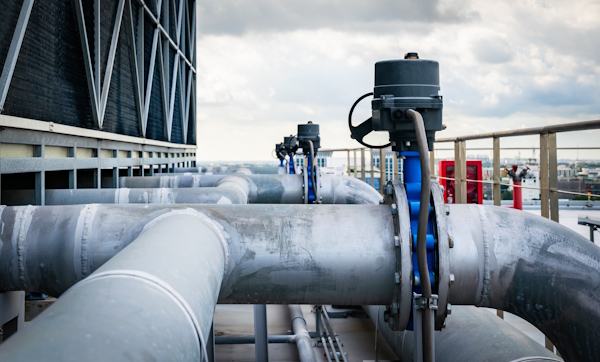
Figure 2: Butterfly valves operating as on/off valves on a cooling tower.
Advantages and disadvantages
Water-based HVAC heat transfer systems offer several advantages and disadvantages that must be considered when selecting the appropriate heating and cooling solution for a building. Understanding these pros and cons can help in making an informed decision that aligns with the specific needs of the facility.
Advantages
- Efficiency: Water has a high specific heat capacity, which means it can carry a significant amount of heat energy with minimal temperature change, making these systems highly efficient in transferring heat.
- Comfort: Hydronic systems provide even and consistent heating without the drafts associated with forced-air systems. This results in a more comfortable indoor environment.
- Versatility: Water-based systems can be designed to provide both heating and cooling, and they can be easily zoned to control temperatures in different areas of a building.
- Quiet operation: These systems operate with less noise compared to air-based systems, as water is a less turbulent medium and the equipment can be isolated from occupied spaces.
- Longevity: With proper maintenance, water-based HVAC systems can have a long operational life due to the durability of their components and the non-corrosive properties of water when treated correctly.
- Space efficiency: The components, such as pipes and radiators, require less space than ductwork, making water-based systems suitable for buildings with limited space.
Disadvantages
- Installation cost: The initial installation cost of water-based systems can be higher than that of traditional forced-air systems due to the complexity of the piping and equipment required.
- Maintenance requirements: Regular maintenance is essential to prevent issues such as leaks, corrosion, and scale buildup, which can affect system performance and longevity.
- Freezing risk: In colder climates, there is a risk of water freezing within the pipes, which can cause damage if the system is not properly maintained or if antifreeze solutions are not used.
- Retrofitting challenges: Retrofitting a water-based system into an existing building can be more challenging and disruptive than installing a traditional air-based system.
- Slower temperature adjustment: Water-based systems may respond more slowly to thermostat adjustments compared to air-based systems, which can heat or cool a space more rapidly.
- Potential for leaks: Any system that uses water runs the risk of leaks, which can lead to water damage and require prompt repair to prevent further issues.
Alternative fluid heat transfer systems
While water-based HVAC heat transfer systems are widely used, there are alternative fluid heat transfer systems that utilize different mediums to convey thermal energy. These alternatives can offer unique benefits and may be more suitable for certain applications or environments.
-
Refrigerant-based systems
- Refrigerant-based systems, such as direct expansion (DX) air conditioners and heat pumps, use refrigerants to absorb and release heat. These systems are commonly used in residential and commercial settings.
- Advantages include precise temperature control and the ability to function at a wide range of temperatures.
- Disadvantages may include the potential environmental impact of refrigerant leaks and the complexity of the refrigerant management regulations.
-
Glycol systems
- Ethylene or propylene glycol solutions are used in systems where freezing temperatures are a concern, as glycol has a lower freezing point than water.
- Advantages include freeze protection and corrosion inhibition, making them suitable for colder climates and for systems with mixed-metal components.
- Disadvantages include lower heat transfer efficiency compared to water and the need to monitor glycol concentration levels to maintain system performance.
-
Oil systems
- Thermal oils or heat transfer oils are used in high-temperature applications, such as industrial processes, where water would vaporize.
- Advantages include the ability to operate at very high temperatures without high pressures and good thermal stability.
- Disadvantages include the potential for fire hazards if the oil leaks and reaches an ignition source, and the need for specialized equipment that can handle the high temperatures.
-
Air systems
- Air can be used as a heat transfer medium in systems such as forced-air heating and cooling. These systems circulate air directly to provide temperature control.
- Advantages include simpler installation and maintenance, as well as the elimination of leak risks associated with liquid-based systems.
- Disadvantages include lower heat transfer efficiency and the potential for uneven heating or cooling distribution within the space.
-
Solar thermal systems
- Solar thermal systems use solar energy to heat a transfer fluid, which is then used to provide space heating or domestic hot water.
- Advantages include the use of renewable energy, which can reduce operating costs and environmental impact.
- Disadvantages include the reliance on sunlight availability, which can be inconsistent, and the need for a backup system for cloudy days or nighttime use.




